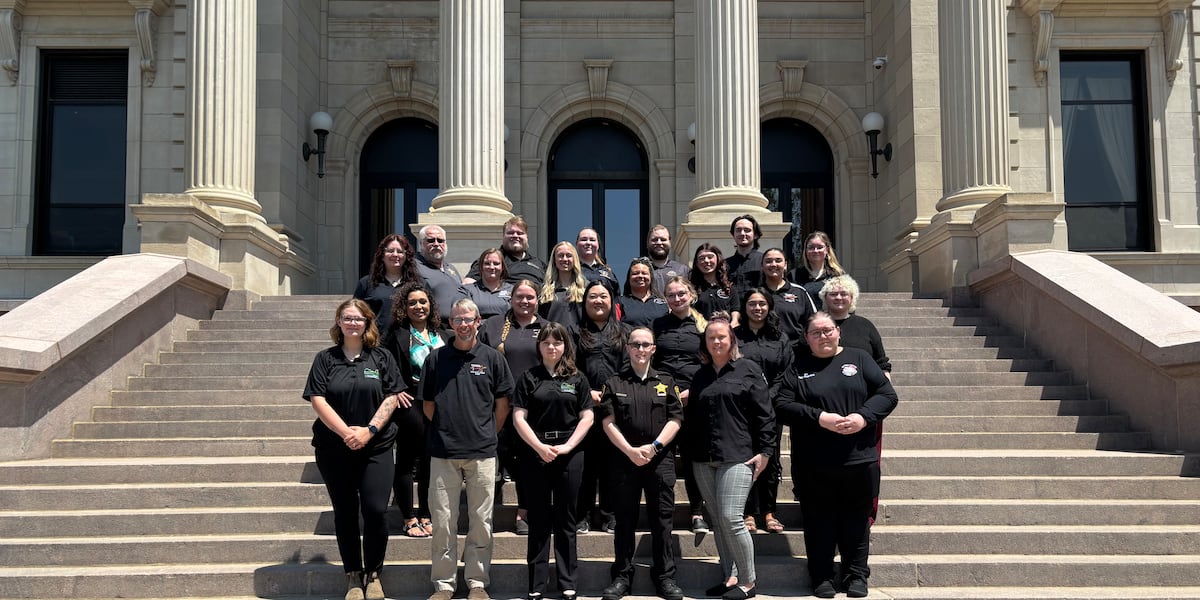Bethenny Frankel Says Daughter Bryn Cried and Begged to Move to Florida
Connecticut
A small CT town looks at racial disparities in policing. It seeks to direct ‘resources fairly and equitably’

The Clinton Police Department has revealed the results of a data analysis aimed at pinpointing racial disparities in policing.
The initial study, carried out by the California-based Center for Policing Equity, reveals that a disproportionate number of traffic stops in Clinton involve Black and Latino motorists, compared to the town’s overall racial makeup.
“We’ve worked with dozens of departments across the country and we see similar disparities pretty much everywhere we go, so Clinton is not the exception,” said researcher Matthew Graham.
“It’s very simple to get yourself locked into the daily things that you do every day and, and you can easily miss things, maybe miss certain groups,” said Clinton Police Chief Vincent DeMaio at a press conference discussing the results. “To have another set of eyes on our work really helps us direct our resources fairly and equitably throughout all of our operations.”
DeMaio began the process of working with the Center for Policing Equity several years ago, after hearing about their work at a talk at Yale University. The service is voluntary, and provided at no cost to the police department or town residents.
He said the aim is to be open and transparent with the residents of Clinton.
“Let our community know that we’re engaged in doing this job for the right reasons, and having the data to back it up,” he said.
The initial study, called a Justice Navigator Assessment, looked at data from traffic stops, calls for service and officer-initiated activity from 2018 to 2020.
It found that, of all drivers stopped, 7.2% were Black; 11% were Latino and 78% were white. The population of Clinton is 0.4% Black, 9.3% Latino and 88% white.
Once stopped, Black drivers were searched 2.6 times as often as white drivers, and arrested 2.3 times as often as white drivers. Latino drivers were searched 2.1 times as often as white drivers, and arrested 1.7 times as often as white drivers.
Graham said the aim of the study is not to place blame, but to seek solutions.
“In this country we tend to think of racism as defective hearts and minds or bad actors,” he said. “That’s not what we’re talking about here. When we talk about racism and racial disparities, we’re talking about the structural policy level factors that could lead to disparities, even if the entirety of the department, even if every officer in Clinton was 100% free of prejudice or bias.”
Clinton is the third town in Connecticut to publicly release results from a study carried out by the Center for Policing Equity. The Center’s Justice Navigator also contains results from Watertown and Newington.
Center staff say they are working with other communities in the state, but not all have yet gone public with their results.
At the press conference, some residents raised questions about how the large Clinton Crossing mall might be skewing the data collected in the study.
“It basically doubles our town population every single day and even more than that on the weekend,” conceded DeMaio, saying at this point the data has not been broken down to show how many of those stopped were Clinton residents or visitors.
“If it’s location driven as we think, then that’s a reasonable explanation,” he said, of the results. “We can back that up with data. If I have one officer that is stopping a disproportionate number of Black or Hispanics, then I probably got a discipline problem that we need to look at.”
Graham said they may consider including the information in a future iteration of the report, but he cautioned that policing disparities should not be experienced by drivers no matter where they come from.
“Whether they’re from a neighboring jurisdiction or driving through from out of state, or whether they’re local residents, it shouldn’t really matter as to how they encounter policing in your community,” he said.
The Clinton Police Department will continue to work with the Center on the next phase of the process which is aimed at addressing the findings through a harm reduction analysis.
DeMaio described the initial report as just the beginning of the relationship.
“We’re going to continue to work with them to look at any kind of anomalies that we see in the data,” he said. “If there’s any shortcomings or any disparities that need to be addressed, we’re going to address that with them.”
Harriet Jones is a freelance writer in Connecticut.

Continue Reading
Connecticut
Advocates highlight services available after an overdose spike in Hartford

Kelly Gay of Windsor is in long-term recovery from substance use disorder.
“I was 18 years old, I was using drugs daily, I was homeless, I was in a great deal of trouble,” Gay said.
She knows first-hand the stigma surrounding the disorder.
“There is some idea we have some choice in this, there is some idea that we are morally flawed and that we can control this if we wanted to,” she said.
Gay wants to change the narrative as new data comes out. This week, the Connecticut Department of Public Health released its drug overdose report, showing a 26% decline in overdose deaths across the state in 2024, compared to 2023. During the same time period in Hartford, deaths dropped 33%. Gay said while she is hopeful about the numbers, she is still concerned.
“Every overdose is a family member, a mother, a child, all things that we all have in our lives, and when you lose someone like that it is never the same,” Gay added.
In 24 hours, there were seven overdose hospitalizations in Hartford, according to city health officials.
Gay, along with Root Center for Advanced Recovery Senior Counselor Ray Bishop, wants the public to be educated about what resources are available.
“One death is one too many. I think on a daily basis we do our best to minimize the risk and to cut down on that death rate,” Bishop said.
The Root Center is the largest methadone provider in the state, serving 5,500 people daily across 14 locations. Bishop said the first step in helping a patient is getting them in the door.
“So that individual has to want to change for anything to happen,” Bishop added.
After that, Bishop said it’s about offering a wide range of resources, so the patient knows they are cared for.
“We have treatment, we have mental health services, we have group support, so it’s not just you come and get the medication, but you have supportive people who are empathic to a situation, with folks who can identify,” Bishop added.
On June 23, the Root Center is welcoming patients to its new Hartford clinic on Lafayette Street, and next spring, the center will begin accepting patients at its first residential treatment facility in New Britain.
Connecticut
Student Encounters 2 Bears Getting Off School Bus: Report: CT News

Patch PM CT brings you the breaking and trending news stories from all across Connecticut each weekday evening. Here are the top headlines. Click on the link to read each story. Thank you for reading.
What would you do if you encountered not one but two black bears? Well, that situation really happened to a 13-year-old student, who exited the school bus and came across two black bears, according to a report.>>>Read More.
A man accused of sexually assaulting a young girl for years and distributing pornographic materials of the child online has been slapped with a $32 million civil judgment against him.>>>Read More.
Police saw the 1-year-old child in the backseat, police said. The driver did not have a valid driver’s license, and the vehicle was both unregistered and uninsured, according to police.>>>Read More.
A Connecticut resident is $1 million richer after winning a massive lottery prize.>>>Read More.
The popular bookstore chain plans to open a new store in Connecticut this month and has confirmed plans for more store openings in 2025.>>>Read More.
The popular ice cream chain has announced a new summer promotion offering $1.99 scoops for a limited time at participating stores.>>>Read More.
Connecticut
Inside Bethenny Frankel’s $7.8M Sale of Applejack Farm in Connecticut

Bethenny Frankel has sold her Connecticut home, also known as Applejack Farm, for more than $7.8 million.
The estate, which is located in Greenwich, Connecticut, closed for $7,825,000. The sale was represented by Jeff Jackson, a broker and owner of Corcoran Centric Realty. Martha Z. Jeffrey and Anne Z. Ogilvy of Sotheby’s International Realty represented the buyer.
Applejack Farm is located in a gated area of the Golden Triangle neighborhood, just minutes outside of Greenwich. Frankel, 54, originally purchased Applejack Farm for $4,250,000 in 2021.
The home was first built in 1743 and is considered to be one of the oldest homes in Greenwich. Over the years, the Real Housewives of New York City alum renovated and added on to the property, ultimately increasing its value.
The property boasts five bedrooms, six bathrooms, two half bathrooms, grand historic rooms, a La Cornue-equipped kitchen, a primary suite with dual spa-grade bathrooms, a lower level with a media room, entertainer’s bar, gym and more. The estate also features a guest cottage that includes two bedrooms, two and half bathrooms, a three-bay garage, a standalone studio and a party barn.
Across its buildings, Applejack Farm has numerous architectural details, including beamed ceilings, brick fireplaces, paneled walls, ornate moldings, an antique bar and more.
The grounds of Applejack Farm included a wide array of trees and rolling green lawns. The plush landscape is accentuated with intricate lighting, a luxe stone patio, a storage shed and a covered porch overlooking the stunning view.
Back in April, Frankel announced that she was migrating south to the Sunshine State.
“I am moving to Florida for personal and professional reasons,” she explained in an Instagram video. “Something has arisen that made this the best and healthiest for myself and my daughter.”
That same month, she quietly placed her Connecticut home up for sale for $8 million.
Before making her relocation official, Frankel reportedly purchased a condo in Miami, which serves as her secondary Florida home. She bought the property for about $1.7 million in June 2024.
After settling in, Frankel gave fans an inside look to her home and new life in the Sunshine State.
“The transition and journey has been rough but in a few weeks we will be settled into our Florida home before we head to the Hamptons for an endless summer,” she wrote via Instagram in May alongside moments of her time in Miami so far. “Let the adventure era continue.”
-

 West6 days ago
West6 days agoBattle over Space Command HQ location heats up as lawmakers press new Air Force secretary
-

 World1 week ago
World1 week agoTwo suspected Ugandan rebels killed in Kampala explosion
-

 Politics1 week ago
Politics1 week agoRed state tops annual Heritage Foundation scorecard for strongest election integrity: 'Hard to cheat'
-

 Technology7 days ago
Technology7 days agoiFixit says the Switch 2 is even harder to repair than the original
-

 News1 week ago
News1 week agoStabilizing 'operations,' the National Weather Service hires again after Trump cuts
-

 Movie Reviews1 week ago
Movie Reviews1 week agoStream It Or Skip It: ‘Sinners’ on VOD, Ryan Coogler's ambitious vampire epic set in the segregated South of the 1930s
-

 World1 week ago
World1 week agoEU-Ukraine trade reset: What comes after tariff-free access expires?
-

 Politics1 week ago
Politics1 week agoHawley clashes with UPenn law professor over judicial injunctions


















